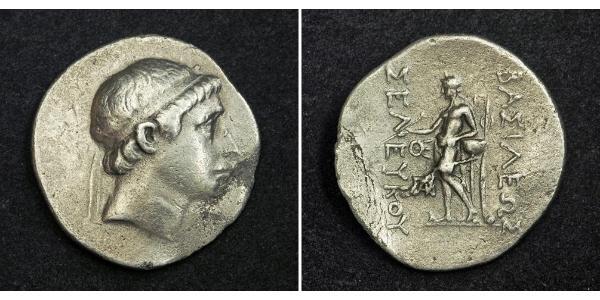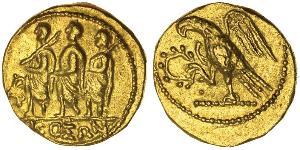(Vendida por $255.0)
Seleucid Kings of Syria, Seleucus II Callinicus (246-226 BC) AR Tetradrachm.
Mint Place: Smyrna?
Mint Period: 246-245/2 BC
Denomination: AR Tetradrachm (Four Drachmai)
Reference: SC 649.3 var. (same monograms, but here on outer left)
Condition: Damaged (creased and cleaned with traces of corrosion), otherwise about VF.
Weight: 16.43gm
Diameter: 30mm
Material: Silver
Obverse: Diademed head of Seleucus II Callinicus ("the gloriously triumphant") right
Reverse: Apollo Delphios, holding arrow, leaning on tripod; two monograms to inner left.
The tetradrachm (Greek: τετράδραχμον) was an Ancient Greek silver coin equivalent to four drachms. It was in wide circulation from 510 to 38 BC. The currency's use was also popular in Greek-influenced areas of present-day Persia and India.
em>.
Seleucus II Callinicus or Pogon (Greek: Σέλευκος Β΄ ὁ Καλλίνικος, ὁ Πώγων; the first epithet means "gloriously triumphant"; the second, which is a nickname, means "the Beard"), was a ruler of the Hellenistic Seleucid Empire, who reigned from 246 to 225 BC. After the death of this father, Antiochus, he was proclaimed king by his mother, Laodice in Ephesos, while her partisans at Antioch murdered Berenice and her son, another Antiochus.
This dynastic feud began the Third Syrian War. Ptolemy III, who was Berenice's brother and the ruler of Egypt, invaded the Seleucid Empire and marched victoriously to the Tigris or beyond. He received the submission of the Seleucid Empire's eastern provinces, while Egyptian fleets swept the coast of Asia Minor.
Seleucus managed to maintain himself in the interior of Asia Minor. When Ptolemy returned to Egypt, Seleucus recovered Northern Syria and the nearer provinces of Persia. However, Antiochus Hierax, a younger brother of Seleucus, was set up as a rival in Asia Minor against Seleucus by a party to which Laodice herself adhered.
At the Battle of Ancyra (about 235 BC) Seleucus sustained a crushing defeat and left the country beyond the Taurus to his brother and the other powers of the peninsula. Seleucus then undertook an anabasis to regain Parthia, the results of which came to nothing. According to some sources, he was even taken prisoner for several years by the Parthian king. Other sources mention that he established a peace with Arsaces I, who recognized his sovereignty.
In Asia Minor, Pergamon now rose to greatness under Attalus I. Antiochus Hierax, after a failed attempt to seize his brother's dominions when his own were vanishing, perished as a fugitive in Thrace in 228 or 227 BC.
About a year later, Seleucus was killed by a fall from his horse. Seleucus II married his cousin Laodice II, by whom he had five children and among them were: Antiochis, Seleucus III Ceraunus and Antiochus III the Great. He was succeeded by his elder son, Seleucus III Ceraunus, and later by his younger son Antiochus III the Great.

1 Denario República romana (509BC-27BC) ...
grupo tiene 41 monedas / 39 precios
Add coin to this group

1 Tetradracma Antigua Grecia (1100BC-330 ...
grupo tiene 31 monedas / 31 precios
Add coin to this group

1 Tetradracma Imperio seléucida (312BC-6 ...
grupo tiene 23 monedas / 21 precios
Add coin to this group

1 Tetradracma Artaxiad dynasty (190BC - ...
grupo tiene 56 monedas / 3 precios
Add coin to this group
Una de ellas es



















